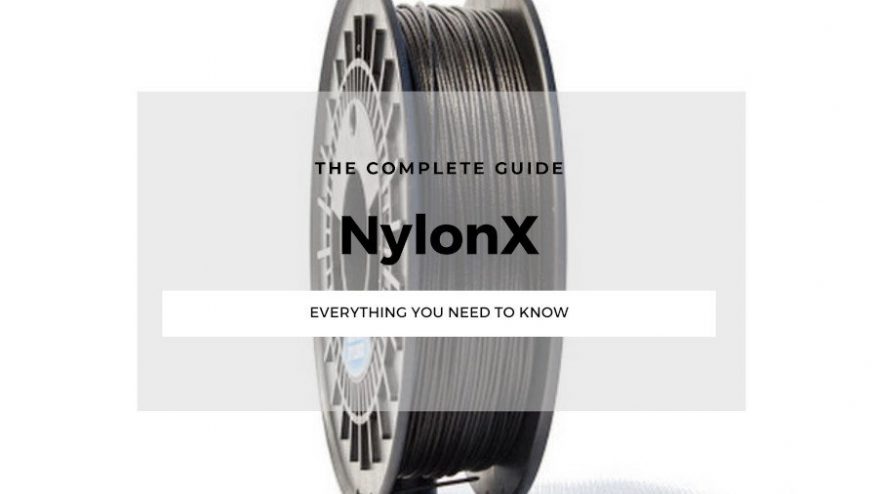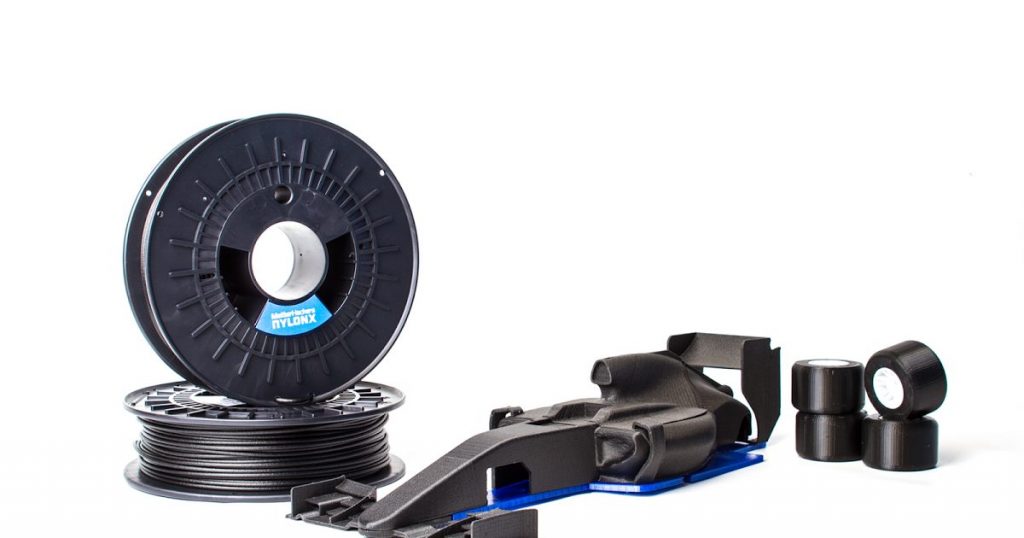
When weighing up filaments for 3D printing, a common compromise is sacrificing accuracy for stability or vice versa. NylonX filament boasts strength in both.
NylonX (also written as Nylon X or Nylonx) has grown in popularity over the years, and is prized for its variety of uses and dependable strength.
- We also have a separate guide for carbon fiber 3D printing.
- We also have a full guide to every 3D printer filament.
Introduction to NylonX Filament
Nylon and its composites are known for their robustness and heat resistance, which is why nylon carbon fiber is commonly found in machines with moving parts such as power tools and vehicles.
NylonX is a nylon filament with woven in carbon fibers to take advantage of this resilience in 3D printing. Brought to the market a few years ago, it is an industrial-grade filament that can be used for home printing.

Using micro-carbon fibers for durability, NylonX boasts not only tensile strength, but impact resistance and versatility, making it ideal for moving mechanisms and gears or heat resistant vehicle parts.
Best NylonX 3D printers
| Name/Brand | Build Volume (mm) | Price | Where to buy? |
|---|---|---|---|
| Pulse XE | 250 x 220 x 215 | $999 | Matterhackers here |
| Ultimaker S3 | 230 x 190 x 200 | $3,850 | Dynamism here |
| Raise3D Pro2 | 305 x 305 x 300 | $3,999 | Dynamism here |
| Makerbot Method Carbon Fiber Edition | 190 x 190 x 196 | $3,499 | Dynamism here |
| XYZprinting PartPro300 xT | 295 x 300 x 300 | $5,500 | Dynamism here |
| Ultimaker S5 | 330 x 240 x 300 | $5,995 | Dynamism here |
NylonX 3D Printing Settings
NylonX 3D Printer Temperature & Heat Bed Temperature
While nylon filaments can extrude at lower temperatures than most, they will be more fragile if not hot enough. Because of this, Matterhackers recommends a metal hotend and a printing temperature of 250-265°C (482-509°F) for the most reliable results.
The printer bed should be glue applied to glass heated at about 60-70°C (140-158°F), this ensures solid bed adhesion.


NylonX 3D Printer Settings
Nylon carbon fiber has no strict limit on printer speed, and can handle anything between 10-80mm/s. The settings should be adjusted according to the printer’s capability and the type of nozzle.
Layer fans – fans that cool the material as it comes out – are not recommended when printing with NylonX as this could increase the chance of warping.
NylonX 3D Printer Nozzles
Weaker brass nozzles are more prone to damage or even destruction due to the abrasiveness of carbon fiber filaments. As a result of this, a stainless steel or hardened steel nozzle is recommended as they are more durable and last longer before being worn down.
- Read more in our complete 3D printer nozzle buyer’s guide
Printers with more fragile parts should be set to lower speeds. Higher printing speeds with NylonX risks damaging some nozzles, and can also cause ruined prints.
As a rule, larger nozzles are capable of working with stronger filaments and printing stronger things. For carbon fiber filaments, a nozzle width of more than 0.6mm is recommended, with wider ones being used to reduce clogging.
For the best results from the filament, manufacturers recommend printers that can fit an Olsson Ruby Nozzle which is capable of handling tougher filaments, including nylon carbon fiber.
Advantages and Disadvantages of NylonX

Advantages of NylonX
- Great heat resistance: Nylon carbon fiber stays sturdy even in very high temperatures and climates.
- Reliable: NylonX is an industrial grade filament that can be printed at home on affordable 3D printers.
- Durable: Matterhackers NylonX tests show that it is capable of withstanding an average of 364lbs of pressure.
- Great surface finish: NylonX doesn’t require sanding and polishing like many other filaments.
- High tensile strength: Very strong despite its low weight
Disadvantages of NylonX
- Highly abrasive: Nylon carbon fiber filaments can damage standard brass nozzles, it’s better to use steel nozzles instead.
- High shrink rates: Like many nylon carbon filaments, NylonX is prone to warping. This is a problem for particularly intricate parts that are rendered unusable if deformed. As a result, using a high temperature heat bed and an enclosed 3D printer are recommended for less warping.
- Not universally usable: Not all 3D printers can handle the high temperatures required for printing with NylonX.
- Prone to moisture absorption: Nylon carbon fiber filaments are hygroscopic, meaning they absorb atmospheric moisture. This can cause problems during the printing process unless it’s stored in a dry, airtight place at all times.
Storing NylonX Filament
Due to its hygroscopic nature (atmospheric moisture absorption), a PrintDry system is also important to make sure NylonX is kept bone dry to reduce the risk of failure during printing. Nylon filaments are especially prone to absorbing moisture from the air, and if left out in the open for too long print quality and surface finish will noticably deteriorate.
If a PrintDry system isn’t available, NylonX should be put in the oven for 6-8 hours at 180°C and cooled in an airtight space before use. This is especially important as nylon carbon fibers absorb moisture extremely easily.

What is NylonX used for? NylonX Applications
Skateboard Wheels
American digital manufacturing company Matterhackers advertize NylonX as a multi-purpose filament for parts that need to be both durable and reliable, which they owe to the.
In 2018, Matterhackers experimented using NylonX for skateboard parts. Skateboard parts need to be strong and durable to ensure safety and longevity through even constant use.

Skateboard parts become dangerous if deformed by weather or wear. NylonX’s nylon fiber base can withstand hot conditions from the summer sun or friction. Not only that, but skateboards need to be light enough to use for both tricks and travel.
All of these reasons point to NylonX as the ideal material for Skateboard parts.
Bicycle Pedals
Because NylonX is a carbon fiber blend, it can withstand the pressure of being stood on if printed with the correct design. While bike pedals may seem like a basic design, they need to be strong enough to hold the rider’s weight and pressure, and durable enough last well through everyday use.


Serious cyclists know that every gram counts, making NylonX’s light weight ideal. Ensuring that a bike pedal can hold an adult’s weight is important for safety, especially at high speeds. NylonX is a durable enough material to lower the risk of potentially serious accidents by ensuring that pedals won’t break mid-use.
Paddleboard Parts
Many paddleboard paddles are already made using nylon carbon fiber because of its light weight, and replacing broken ones can cost over $180 to repair. Because of this, it’s easy to see the appeal in 3D printing one yourself, and NylonX is an ideal material for this.

NylonX carbon fiber filament is durable enough for long lasting strength, and light enough to make sure the board can still comfortably float. NylonX’s heat resistance is also a major advantage as paddleboarding is more popular in hotter climates.




